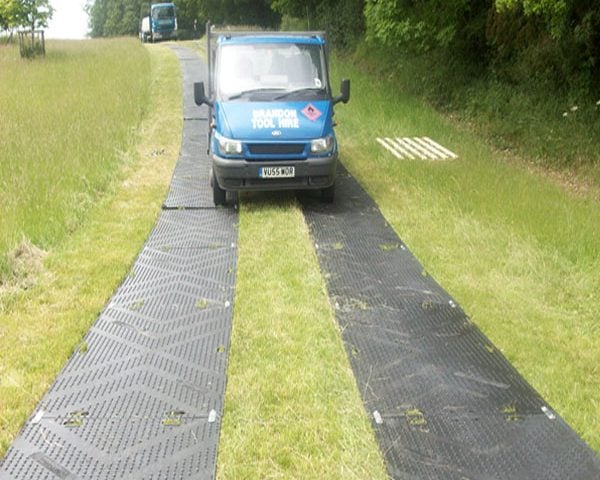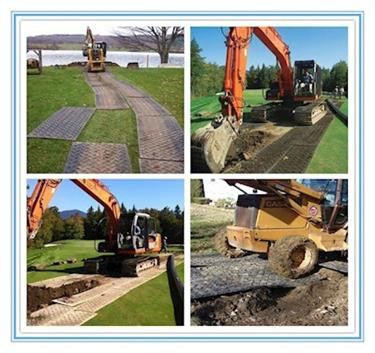- Have any questions?
- +86 185 63982630
- Lacey@peboards.com
16 Reasons NOT to use Plywood for Ground Protection

How to select suitable temporary ground protection mat?
04/29/2019
8 Key Material Benefits of Textured HDPE Sheet
08/23/201916 Reasons NOT to use Plywood for Ground Protection

ground protection mat
How many times have you wanted to start a job, but the day before it rains? Or what about those times when the frost just started leaving the ground and every single yard you try to work in is a sinkhole? Or lastly, the dread of working in the yard with the perfect landscaping that you don’t dare make one divot in the lawn? These are all situations that we, as tree company owners and employees, find ourselves in day in and day out! One of the best investments you can make when it comes to these problems is a bunch of polyethylene ground protection mats!
What is polyethylene ground protection mats?

Polyethylene ground protection mats are heavy duty plastic mats that can be laid down on grass, sidewalks, or other sub surfaces to help support your equipment as well as protect the lawn underneath. They are made out of composite polyethylene (HDPE High Density Polyethylene or UHMWPE Ultra High Molecular Weight Polyethylene). They can come in black, clear or any other colors you want. Surprisingly, these super strong mats are capable of supporting up to 90 tons with an adequate sub surface underneath the equipment!
These mats work extremely well for getting equipment into areas that would never allow it on a normal day! Whether it be pulling the crane far into a backyard to remove a hazard tree or getting the bucket to an enormous prune job, using these mats in the right place can not only save you money with reduced property damage costs, but also make you more money because the jobs can be completed with less man hours involved!
So, I’m sure you are thinking, why not just buy a bunch of plywood and use that for ground protection? Well, you could, but you should also think about the differences between composite ground mats and plywood.
Plywood – it’s great for bracing timber – but here is some reasons why you shouldn’t be using plywood as a ground protection or temporary roadway fix on your construction site.
16 Reasons NOT to use Plywood for Ground Protection
- Plywood is useless after one cycle and often bought, used and thrown out. It has a limited lifespan and NEEDS to be replaced or maintained. This shorter lifespan adds-up to dollars out of your pocket. If you’re regularly traversing lawns, turf, muddy sites, paving or asphalt, you really need something that lasts. PE mats usually have a 6-10 years warranty and will last a lifetime in most applications.
- It is a very hassle to constantly re-ordering plywood boards at different times as plywood’s very limited lifespan.
- Plywood is slippery, it does not provide a treaded traction surface. It lacks a consistent strength from sheet to sheet, especially after being wet and exposed to the elements.
- Plywood lacks a consistent strength from sheet to sheet, especially after being wet and exposed to the elements.
- The average load bearing capacity of plywood mats can vary over time and from sheet to sheet depending on the differences in density, quality, ground weather and overall usage conditions of the wood which causes deterioration at varying rates. This can be a real problem when working with different types of vehicles and machinery.
- Plywood has a low load safety factor. Plywood will easily crack or de-laminate if it comes under too much strain. ProtectaMats are rated to take 80T of load – vastly higher than plywood.
- The porous structure of plywood means that it can absorb a lot of water which accelerates rotting and deteriorates the wood over time. Plywood is not weather-resistant. Come a significant rainfall event, plywood will de-laminate and fail.
- Plywood gets heavier and muddier when wet – making it harder to lift, transport and install.
- Plywood can absorb and even leach other oils, fluids and chemicals posing a serious cross-contamination risk.
- Plywood is also at risk of becoming infested with rodents, insects and bacteria and fungi, especially once rotting sets in which also causes the wood to deteriorate.
- Plywood is unsuitable for use on slopes or inclines, especially if wet!
- Plywood mats can also be a serious safety hazard. Not only is there a risk of splinters and debris which could cause trips and accidents, but the danger of rot and other deterioration could cause them to bend or break unexpectedly. This is extremely problematic for work sites and other industrial settings that need to adhere to strict health and safety practices. They’re also notoriously slippery when wet and can suffer from frost and ice which are serious safety hazards.
- Plywood has a high movement risk – it is not an integrated connection.
- Plywood can absorb harmful chemicals and transfer them to another site.
- Plywood is often treated with formaldehyde which can cause irritation of the skin, eyes, nose, and throat.
- Plywood is not eco-friendly. Plywood is obviously derived from our forests, which, even if sustainably harvested, don’t need their byproducts to be wasted unnecessarily.
The assumption that wooden boards, being a natural product, must be eco-friendly is false for the following reasons:
- Plywood does not contain recycled content.
- Plywood contributes to landfilldy
- Plywood does not save trees
- Plywood cannot be used in environmentally sensitive areas
- Plywood can absorb and spread harmful chemicals
CONCLUSION: COMPOSITE ROAD MATS FANTASTIC!
It is clearly that timber boards are not as cost-effective as they appear to be.
They are barely fit for purpose, pose major safety risks and are extremely perishable, yielding a very poor return on investment.
Plastic ground protection mats, on the other hand, are safe, strong, reusable, long-lasting and eco-friendly. The only way to go!
Feel free to contact us by lacey@peboards.com, and let’s talk more together.
